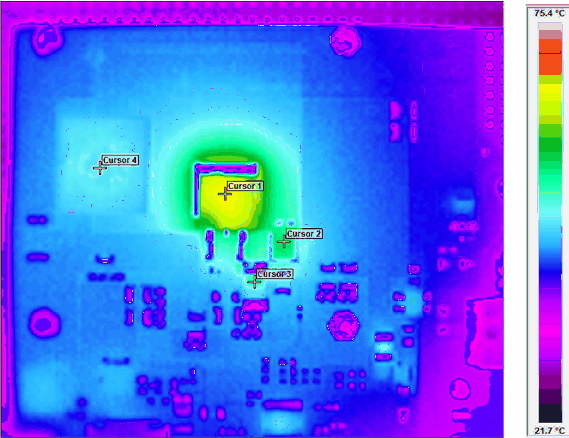JAJU633 October 2018
- 概要
- リソース
- 特長
- アプリケーション
- デザイン・イメージ
- 1System Description
-
2System Overview
- 2.1 Block Diagram
- 2.2 Highlighted Products
- 2.3 LM74700
- 2.4
System Design Theory
- 2.4.1
Design Procedure
- 2.4.1.1 Operating Parameters, Duty Cycle
- 2.4.1.2 Setting the Switching Frequency
- 2.4.1.3 Inductor Value Calculation
- 2.4.1.4 Peak Inductor Current
- 2.4.1.5 Calculating RIS (R9)
- 2.4.1.6 Minimum Output Capacitance
- 2.4.1.7 Setting the LED Current
- 2.4.1.8 Soft-Start Capacitor
- 2.4.1.9 Overvoltage Protection (OVP)
- 2.4.1.10 Main N-Channel MOSFET Selection
- 2.4.1.11 Rectifier Diode Selection
- 2.4.1.12 Thermal Protection
- 2.4.2 Designing for Low EMI
- 2.4.1
Design Procedure
- 3Hardware, Software, Testing Requirements, and Test Results
- 4Design Files
- 5Related Documentation
3.2.2.3 Thermal Scan
Figure 19 shows a thermal scan of the board running at a room temperature (≈ 24°C) with no air flow. Table 2 lists measured temperatures of key components.
 Figure 19. Thermal Scan With Heat Sink—Top-View (Power Components): VIN = 13 V, HB/LB Mode (55 W), ILED = 1.25 A
Figure 19. Thermal Scan With Heat Sink—Top-View (Power Components): VIN = 13 V, HB/LB Mode (55 W), ILED = 1.25 A Table 2. Component Temperatures
| CURSOR | COMPONENT | TEMPERATURE (°C) |
|---|---|---|
| 1 | Q3 | 66.2 |
| 2 | D3 | 56.6 |
| 3 | R9 | 52.3 |
Figure 21 shows a thermal scan of the board running at a elevated temperature (≈ 70°C) with no air flow. Table 3 lists measured temperatures of key components.
 Figure 20. Picture of Heatsink on Board
Figure 20. Picture of Heatsink on Board  Figure 21. Thermal Scan—Top-View (Power Components): VIN = 13 V, HB/LB mode (55 W), ILED = 1.25 A
Figure 21. Thermal Scan—Top-View (Power Components): VIN = 13 V, HB/LB mode (55 W), ILED = 1.25 A Table 3. Component Temperatures
| CURSOR | COMPONENT | TEMPERATURE (°C) |
|---|---|---|
| 1 | Q3 | 114.3 |
| 2 | D3 | 100.8 |
| 3 | R9 | 91.3 |